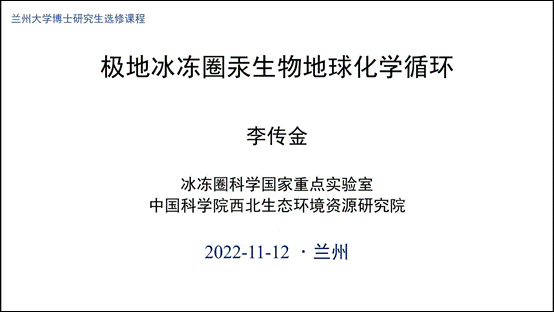On the afternoon of 12 November 2022, at the invitation of Professor Mou CuiCui and Associate Professor Lu Xia from the School of Resources and Environment of Lanzhou University, Research Fellow Li Chuanjin from the Northwest Institute of Ecological and Environmental Resources, Chinese Academy of Sciences (NIEER) taught a course on "Global Cycling of Persistent Toxics" to our 2022 class of Ph.D. students in Resources and Environment. The title of this presentation is Biogeochemical cycling of mercury in the polar cryosphere.
The presentation included four parts: a historical review of mercury and Arctic mercury research, mercury isotope fractionation and the polar cryosphere, progress of mercury research in the Antarctic cryosphere, and an introduction to Chinese Antarctic scientific expeditions. Li Chuanjin explained the physicochemical properties of different forms of mercury and the hazards to organisms, the cumulative amplification effect of methylmercury in organisms, and the biogeochemical cycle of mercury, and summarized the progress of mercury research in the polar cryosphere and the research results obtained. Finally, Li Chuanjin gave patient answers to the questions raised by teachers and students and held lively discussions with them.

Introduction of the speaker:
Li Chuanjin, male, from Dongping, Tai'an, Shandong, China, is a researcher at the Northwest Institute of Ecological and Environmental Resources, Chinese Academy of Sciences. Li has participated in many expeditions to the North and South Poles and the Qinghai-Tibet Plateau in China. Among them, he participated in three Chinese Antarctic scientific expeditions in 2012-2013 (29th), 2015-2016 (32nd) and 2021-2022 (38th); participated in the international Greenland NEEM/EGRIP ice core drilling fieldwork three times in 2009, 2011 and 2018; participated in the State Key Laboratory of Cryosphere Science from 2017-2020 In addition, he participated in more than 20 expeditions to the cryosphere of the Qinghai-Tibet Plateau in China during his study and work. He has published 25 research papers with the first and corresponding authors, including 15 SCI papers. He has hosted and participated in 9 research projects, including one National Basic Research Program (973) sub-topic, two Natural Science Foundation projects, and one youth project.
Main research progress:
1. A study on the monitoring of snow-ice-air modern processes in the ice cap section reveals the spatial pattern of the Antarctic atmospheric environment, and the climate correspondence between the ice cap height section and the latitude section of the Southern Ocean is obtained.
2. The historical ice core sequence of volcanic and solar activity in the interior of the East Antarctic has been reconstructed, and the results provide a basis for the systematic study of the natural drivers of climate change in the East Antarctic and its modeling.
3. To address the possible impact of human activities on the East Antarctic environment, the applicant has used the spatial and temporal distribution records of various environmental indicators (mercury, organic acids) to analyze the disturbance of the global environmental background of the East Antarctic by various natural sources and human activities and to investigate the mechanisms of their impact.